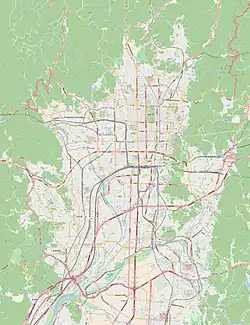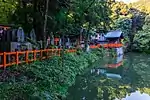Fushimi Inari-taisha
Fushimi Inari-taisha (伏見稲荷大社) is the head shrine of the kami Inari, located in Fushimi-ku, Kyoto, Kyoto Prefecture, Japan. The shrine sits at the base of a mountain also named Inari which is 233 metres (764 ft) above sea level, and includes trails up the mountain to many smaller shrines which span 4 kilometres (2.5 mi) and take approximately 2 hours to walk up.[1]
| Fushimi Inari-taisha 伏見稲荷大社 | |
|---|---|
 Torii leading to the outer shrine | |
| Religion | |
| Affiliation | Shinto |
| Deity | Uka-no-Mitama-no-Ōkami, et al. as Inari Ōkami |
| Type | Inari Shrine |
| Location | |
| Location | Fushimi-ku, Kyoto, Kyoto, Kyoto Prefecture, Japan |
 Shown within Kyoto city  Fushimi Inari-taisha (Japan) | |
| Geographic coordinates | 34°58′2″N 135°46′22″E |
| Architecture | |
| Date established | 711 |
| Website | |
| inari | |
Inari was originally and remains primarily the kami of rice and agriculture, but merchants and manufacturers also worship Inari as the patron of business. Each of Fushimi Inari-taisha's roughly thousand torii was donated by a Japanese business.
Owing to the popularity of Inari's division and re-enshrinement, this shrine is said to have as many as 32,000 sub-shrines (分社 bunsha) throughout Japan.[2]
History







.jpg.webp)
The shrine became the object of imperial patronage during the early Heian period.[3] In 965, Emperor Murakami decreed that messengers carry written accounts of important events to the guardian kami of Japan. These heihaku were initially presented to 16 shrines, including the Inari Shrine.[4]
From 1871 through 1946, Fushimi Inari-taisha was officially designated one of the Kanpei-taisha (官幣大社), meaning that it stood in the first rank of government supported shrines.[5]
Structures
The earliest structures were built in 711 on the Inariyama hill in southwestern Kyoto, but the shrine was re-located in 816 on the request of the monk Kūkai. The main shrine structure was built in 1499.[6] At the bottom of the hill are the main gate (楼門, rōmon, "tower gate") and the main shrine (御本殿, go-honden). Behind them, in the middle of the mountain, the inner shrine (奥宮, okumiya) is reachable by a path lined with thousands of torii. To the top of the mountain are tens of thousands of mounds (塚, tsuka) for private worship.
Fox
Foxes (kitsune), regarded as the messengers, are often found in Inari shrines. One attribute is a key (for the rice granary) in their mouths.
Unlike most Shinto shrines, Fushimi Inari-taisha, in keeping with typical Inari shrines, has an open view of the main object of worship (a mirror).
A drawing in Kiyoshi Nozaki's Kitsune: Japan's Fox of Mystery, Romance and Humor in 1786 depicting the shrine says that its two-story entry gate was built by Toyotomi Hideyoshi.
The shrine draws several million worshipers over the Japanese New Year, 2.69 million for 3 days in 2006 reported by the police, the most in western Japan.
 Fox holding a key in its mouth, at the main gate of the Fushimi Inari shrine
Fox holding a key in its mouth, at the main gate of the Fushimi Inari shrine Fox holding a jewel in its mouth at the main gate of the Fushimi Inari shrine
Fox holding a jewel in its mouth at the main gate of the Fushimi Inari shrine Fox sculpture in Fushimi Inari-taisha shrine
Fox sculpture in Fushimi Inari-taisha shrine Fox fountain in Fushimi Inari-taisha shrine
Fox fountain in Fushimi Inari-taisha shrine Another view of the fox fountain
Another view of the fox fountain Fox altar in Fushimi Inari-taisha shrine
Fox altar in Fushimi Inari-taisha shrine
Access
The shrine is just outside the Inari Station on the Nara Line of the West Japan Railway Company (JR), a five-minute ride from Kyoto Station. It is a short walk from Fushimi-Inari Station on the Main Line of the Keihan Electric Railway.[7]
The shrine is open 24 hours with both the approach to the shrine and the Honden (本殿, main hall) itself illuminated all night. There is no entrance fee.
Environs
In the approach to the shrine are a number of sweet shops selling tsujiura senbei (辻占煎餅), a form of fortune cookie dating at least to the 19th century, and which are believed by some to be the origin of the American fortune cookie.[8][9][10]
In popular culture
- Memoirs of a Geisha (2005)
- Aria the Natural ep. 5 (2006)
- Inari, Konkon, Koi Iroha (2010)
- Rurouni Kenshin, site of Makoto Shishio's base
- Kamen Rider Fourze ep. 33 (2012)
- Samsara (2011 film) (2011)
- High School Inari Tamamo-chan' ', where the main character a fox spirit came from along with her siblings.
A part of the Noh play Kokaji takes place in Fushimi Inari-taisha.[11]
Image gallery
 View of the south-western wing of Senbon Torii path.
View of the south-western wing of Senbon Torii path. View of the north-eastern wing of Senbon Torii path.
View of the north-eastern wing of Senbon Torii path.
References
Citations
- 全国のお稲荷さんの総本宮、伏見稲荷大社を参拝しました。 [Nationwide Inari Shrines, I visited the Fushimi Inari-taisha.] (in Japanese). Retrieved 28 March 2014.
- Motegi, Sadazumi. "Shamei Bunpu (Shrine Names and Distributions)". Encyclopedia of Shinto. Retrieved 31 March 2010.
- Breen, John et al. (2000). Shinto in History: Ways of the Kami, pp. 74-75.
- Ponsonby-Fane, Richard. (1962). Studies in Shinto and Shrines, pp. 116-117.
- Ponsonby-Fane, Richard. (1959). The Imperial House of Japan, pp. 124.
- Nussbaum, Louis-Frédéric et al. (1998). Japan encyclopedia, p. 224.
- Fushimi Inari Shrine, How to get there
- Lee, Jennifer 8. (January 16, 2008). "Solving a Riddle Wrapped in a Mystery Inside a Cookie" The New York Times. Retrieved on January 16, 2008.
- 8. Lee, Jennifer (January 16, 2008). "Fortune Cookies are really from Japan". The Fortune Cookie Chronicles. Archived from the original on 2011-07-25.
- Ono, Gary (2007-10-31). "Japanese American Fortune Cookie: A Taste of Fame or Fortune -- Part II".
- "Kokaji (pamphlet)" (PDF). noh-kyogen.com. Retrieved 2018-01-09.
Bibliography
- Breen, John and Mark Teeuwen. (2000). Shinto in History: Ways of the Kami. Honolulu: University of Hawaii Press. ISBN 978-0-8248-2363-4
- Nussbaum, Louis-Frédéric and Käthe Roth. (1998). Japan encyclopedia. Cambridge: Harvard University Press. ISBN 978-0-674-01753-5
- Ponsonby-Fane, Richard. (1962). Studies in Shinto and Shrines. Kyoto: Ponsonby Memorial Society. OCLC 399449
- Ponsonby-Fane, Richard (1959). The Imperial House of Japan. Kyoto: Ponsonby Memorial Society. OCLC 194887
- Smyers, Karen A. (1997). Inari pilgrimage: Following one’s path on the mountain, Japanese Journal of Religious Studies 24 (3-4), 427-452
External links
| Wikimedia Commons has media related to Fushimi Inari-taisha. |
- Official Site (ja)
- Official Site (en)
- Photographs of Fushimi Inari-taisha
- Accessibility information
- 96291583 Fushimi Inari-taisha on OpenStreetMap